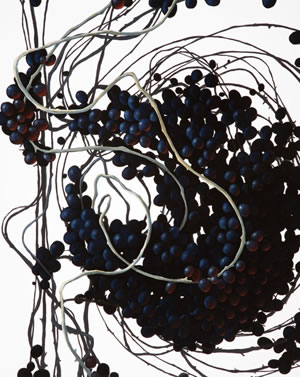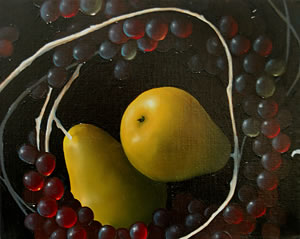
| return to top |
| return to top |
| return to top |
|
MIA BROWNELL
MIA BROWNELL Embracing the Void: The Spinning Festoons of Mia Brownell Mia Brownell's paintings from her recent series "Adventures of a Reluctant Omnivore" give the viewer a slight sensation of disorientation. Swirls of leafless branches with fruits attached spiral towards us from a deep, warm, dark background, or they appear to hang helplessly in a white vacuum. Where are we? And what exactly are we looking at? Evidently, Brownell has been influenced by early-modern still lifes, in particular the fruit and flower pieces of seventeenth-century Dutch masters. Her traditional technique — employed refreshingly — allows her to meticulously render her apples, grapes, apricots just as her predecessors did. The great difference is that in Baroque still lifes gravity rules: glasses have tumbled, skulls have rolled to their sides, pieces of bread lay scattered, musical instruments balance on edges of table-tops, and all the while the ubiquitous lemon peel spirals downward endlessly. Brownell does not grant her objects such grounding. Her fruits hang in mid-air as if weightless. Breathing a kind of lightness, her paintings do not so much build on the genre of still life as on its distant relative, the festoon, that antique ornament made for suspension. Dating back to the early Greek period, the festoon was originally an actual garland decorating skulls of sacrificed beasts. Ever since, festoons as devices have appeared on temple fronts and Roman sarcophagi; have framed Renaissance frescoes or windows on palace facades; and have emerged in plaster as decorative element in rococo interiors. Though the festoon, incidentally, has been elevated by Pieter Paul Rubens, Jan Bruegel and Jan Davidsz de Heem as the main subject of their oil paintings, it has largely remained ornamental. One thing Brownell has done is put an end to the festoon's life at the margins. Placing it on centre stage, she has refashioned this festive albeit banal ornament, creating a classical device with a playful — and quite literal — twist. Whereas seventeenth-century masters carefully composed neatly draped, flowery rampages, Brownell's festoons are spinning out of control. Leafless branches spiral out of frame, a few fruits dangerously dangling here and there. These fruits are about to be swept out of our sight, but at a rather slow pace, as the barren branches unfold in their own strangely unearthly way, almost like a nebulous galaxy. Differing from the dangling apples, the tiny grapes (and are we sure they are grapes?) cling to the twigs as if they were a parasitical, prolific plant species. Appearing as a close-up of a part incorporated in later pieces such as Still Life with Sympathy for Eve (2007), Brownell's Still Life with Helix (2006) shows the creeping berries are to be somehow deeply organic, bodily even, reminiscent of models of cells or proteins blown up to gigantic proportions. Indeed, Still Life with Double Double further confirms Brownell's interest in molecular models. We see a pair of helixes consisting of intertwined twigs covered with tiny grapes that mimic miniscule, abstract structures like those in images of DNA strands. Paradoxically, and likely due to Brownell's immaculate technique, I am reminded of the inside of a body, a rib cage perhaps, that I have seen in Rembrandt's, Soutine's or Bacon's slaughtered oxen. Brownell's work thus attempts to give traditional objects and themes a new spin, or rather an alternative set-up that is surprisingly fitting. The molecular composition, as I would call it, ultimately reveals a curiosity, or rather, a passion for empty interiors, the voids around which these works curl. We see this interest also in Still Life with Cock — the chicken, fridge-cold, is virtually obscene in showing the gaping cavity of its carcass — or in Still Life with Adam, in which a lamb's rib spirals according to its molecular composition while at the same time evoking a lemon peel. Though at times appearing as if the branches tenderly embrace emptiness, in fact the void is a forceful power ruling over the composition, willfully pushing it to its unsettling, bottomless depths, where no viewer's eye can follow. Hanneke Grootenboer is a University Lecturer in the History of Art Department at Oxford University. She is interested in theories of vision in early modern painting, in particular in perspective, illusionism and visual rhetoric. Grootenboer has also lectured at Tulane University in New Orleans, Columbia University in New York, and the Amsterdam School for Cultural Analysis at the University of Amsterdam, The Netherlands. |
||||||||||||||||||
|
|||||||||||||||||||
HOME . ABOUT US . ARTISTS . CURRENT EXHIBITION . UPCOMING EXHIBITION
ARCHIVE . DIRECTIONS-MAP . CONTACT . SUBMISSIONS












